![]()
![]()
![]()
Use LEFT and RIGHT arrow keys to navigate between flashcards;
Use UP and DOWN arrow keys to flip the card;
H to show hint;
A reads text to speech;
10 Cards in this Set
- Front
- Back
- 3rd side (hint)
|
Sagittal Plane |
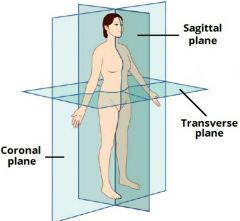
A vertical line which divides the body into a left section and a right section. |
|
|
|
Coronal Plane |

A vertical line which divides the body into a front (anterior) section and back (posterior) section. |
|
|
|
Transverse Plane |
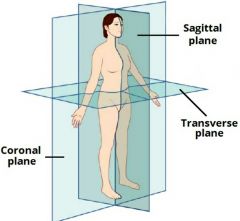
A horizontal line which divides the body into an upper (superior) section and a bottom (inferior) section. |
|
|
|
The Anatomical Position |
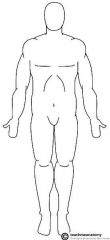
A person standing upright, facing forward. Arms straight and hands held by the hips, palms facing forward. Feet parallel and toes pointing forward. |
|
|
|
Flexion |
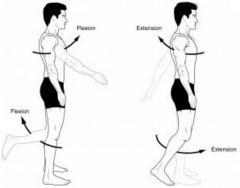
Refers to a movement that decreases the angle between two body parts. Flexion at the elbow is decreasing the angle between the ulna and the humerus. When the knee flexes, the ankle moves closer to the buttock, and the angle between the femur and tibia gets smaller. |
Flexion and extension are movements that occur in the sagittal plane. They refer to increasing and decreasing the angle between two body parts. |
|
|
Extension |

Refers to a movement that increases the angle between two body parts. Extension at the elbow is increasing the angle between the ulna and the humerus. Extension of the knee straightens the lower limb. |
Flexion and extension are movements that occur in the sagittal plane. They refer to increasing and decreasing the angle between two body parts. |
|
|
Abduction |
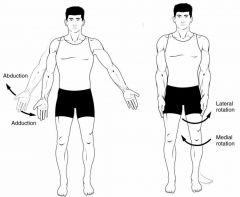
Is a movement away from the midline – just as abducting someone is to take them away. For example, abduction of the shoulder raises the arms out to the sides of the body. |
Abduction and adduction are two terms that are used to describe movements towards or away from the midline of the body. |
|
|
Adduction |
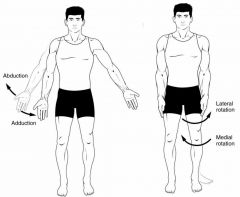
Is a movement towards the midline. Adduction of the hip squeezes the legs together. |
Abduction and adduction are two terms that are used to describe movements towards or away from the midline of the body. |
|
|
Medial Rotation |

Is a rotational movement towards the midline. It is sometimes referred to as internal rotation. To understand this, we have two scenarios to imagine. Firstly, with a straight leg, rotate it to point the toes inward. This is medial rotation of the hip. Secondly, imagine you are carrying a tea tray in front of you, with elbow at 90 degrees. Now rotate the arm, bringing your hand towards your opposite hip (elbow still at 90 degrees). This is internal rotation of the shoulder. |
Medial and lateral rotation describe movement of the limbs around their long axis. |
|
|
Lateral Rotation |
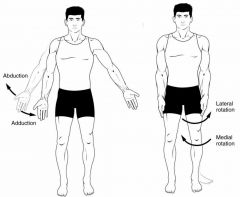
Lateral rotation is a rotating movement away from the midline. It is sometimes referred to as external rotation. To understand this, we have two scenarios to imagine. Firstly, with a straight leg, rotate it to point the toes outward. This is lateral rotation of the hip. Secondly, imagine you are carrying a tea tray in front of you, with elbow at 90 degrees. Now rotate the arm, moving your hand away from the opposite hip (elbow still at 90 degrees). This is external rotation of the shoulder. |
Medial and lateral rotation describe movement of the limbs around their long axis. |

